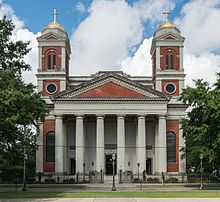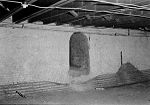Cathedral Basilica of the Immaculate Conception (Mobile, Alabama)
| Cathedral Basilica of the Immaculate Conception | |
|---|---|
 | |
 | |
| 30°41′24″N 88°02′45″W / 30.69000°N 88.04583°W | |
| Location | 2 South Claiborne Street Mobile, Alabama |
| Country | United States |
| Denomination | Roman Catholic Church |
| Website | www |
| History | |
| Founded | 1703 |
| Founder(s) | Most Rev. Michael Portier |
| Architecture | |
| Architect(s) | Claude Beroujon |
| Style | Greek Revival |
| Groundbreaking | 1835 |
| Completed | 1850 |
| Specifications | |
| Number of spires | Two |
| Materials | Brick |
| Administration | |
| Archdiocese | Mobile |
| Clergy | |
| Archbishop | Most Rev. Thomas J. Rodi |
| Rector | Msgr. William J. Skoneki |
| Part of | Church Street East Historic District, Lower Dauphin Street Historic District (ID71000102, 79000392[1]) |
| Added to NRHP | December 16, 1971, February 19, 1979 |
The Cathedral Basilica of the Immaculate Conception (French: Cathédrale de l'Immaculée-Conception de Mobile) is a cathedral serving Roman Catholics in Mobile, Alabama in the United States.
Immaculate Conception is the seat of the archbishop of the Roman Catholic Archdiocese of Mobile. It is named for Mary, mother of Jesus, under her title, Our Lady of the Immaculate Conception.
History
[edit]Early churches
[edit]Mobile's Cathedral Parish was established on July 20, 1703, by Jean-Baptiste de la Croix de Chevrières de Saint-Vallier, Bishop of Quebec. Bishop de Saint-Vallier named Father Roulleaux de La Vente, first pastor of the parish church, which was located at the French settlement of Mobile at the citadel of Fort Louis de la Louisiane.[2] The parish is the first established on the Gulf Coast.
When the Mobile settlement was relocated to its present site in 1711, a new parish church was built and was known as Notre Dame de la Mobile (Our Lady of Mobile).[3] In 1781, during the Spanish occupation of Mobile, the parish took its current name, Immaculate Conception.[4]
Pope Pius VIII erected the Diocese of Mobile in 1829 and appointed Bishop Michael Portier as its first bishop.[5] Portier's first “cathedral” was a small wooden structure located in the Old Spanish Burying Ground, site of the present cathedral. Portier soon set out to construct a "real" cathedral.
Construction and improvements
[edit]In 1833, Portier hired Claude Beroujon, a former seminarian turned architect to create a Roman basilica design for the new Immaculate Conception Cathedral. [6]Portier laid the cornerstone of the cathedral in 1835. However, the financial crisis in the United States known as the Panic of 1837 forced a long delay in the cathedral construction. Portier finally consecrated Immaculate Conceptions in 1850. However, due to lack of funds, he was unable to construct the portico and towers.[7]
On May 25, 1865, at the end of the American Civil War, 30 tons of gunpowder ignited inside an ammunition depot operated by the Union Army in Mobile. The blast killed 300 people and destroyed much of the town.[8] The windows and sashes on the north side of the empty cathedral were blown in by the explosion.[9]
Bishop John Quinlan was finally able in the 1870s to add a classical portico, with eight massive doric columns, to the outside of the cathedral. The two towers were completed in 1884 by Bishop Jeremiah O'Sullivan

In 1946, a US Navy aviator hit the South Tower of the cathedral before crashing his plane and dying.[9]
Fire damage and restoration
[edit]On March 19, 1954, a homeless man sheltering in the church basement caused a fire that raced up through the sanctuary. Two firefighters, both former altar boys, ran into the burning building to retrieve religious objects. The cathedral survived the fire, but the interior suffered heavy fire, smoke, and water damage. Eight of the large stained glass windows were destroyed, along with the cathedra, pulpit and pipe organ. The damage estimate was $250,000, which was not covered by insurance.[9]

After the 1954 fire, Bishop Thomas Toolen sent the damaged stained glass windows to the Franz Meyer workshops in Munich for repair. He replaced the cathedra and pulpit with new mahogany ones. A replacement organ, built by the Wicks Organ Company of Highland, Illinois, was installed. Toolen also added a massive bronze baldachin above the altar, supported by four marble columns.
Recent modifications
[edit]In the 1970s, Bishop John L. May modified the sanctuary in compliance with the 1970 General Instruction of the Roman Missal issued by the Vatican. This document spelled out changes in church layouts from the Second Vatican Council in the 1960's. May moved the altar forward and removed the altar rails. The cathedra was moved to the south end of the sanctuary, facing the congregation. May also added a bronze representation of the Risen Christ above the baldachin and a large crucifix over the tabernacle.
Hurricane Frederic damaged the cathedral steeples in 1979, forcing the parish to replace its wooden crosses with metal ones.[9]
Archbishop Oscar Hugh Lipscomb led the most recent restoration effort in the 2000s. Under his direction, the cast-iron fence was restored and repaired, and the cathedral exterior was cleaned and repaired. An interior overhaul, executed by Conrad Schmitt Studios, included a coffer ceiling above the main aisle. The coffers are decorated with alternating gold-leafed fleur-de-lis and shamrock, symbolically representing the Trinity, as well as the contributions of the French and Irish religious to the life of the Archdiocese. New lighting and a new color scheme brightens the interior. White marble flooring was installed in the aisles and the heart pine floors under the pews were refinished. Embedded in the marble floor of the main aisle are the coats-of-arms of the Mobile bishops and archbishops. A mural of the Tree of Jesse was installed above the pipe organ.

In 2004, Lipscomb presented Pope John Paul II with a photograph of the cathedral.
In 1962, Pope John XXIII elevated the cathedral to a minor basilica. The pope's personal coat-of-arms is installed above the cathedral entrance. The yellow and red umbracullum (umbrella) and tintinnabulum (bell) in the sanctuary.
Location and dimensions
[edit]Immaculate Conception Cathedral is located on South Claiborne Street in Mobile. It is bounded by Dauphin Street on the north, Franklin Street on the west, and Conti Street on the south. The front of the church faces east, toward the Mobile River, and overlooks Cathedral Square.
The cathedral is listed on the National Register of Historic Places as a contributing property to the Church Street East Historic District and the Lower Dauphin Street Historic District. It is part of the Historic Roman Catholic Properties in Mobile Multiple Property Submission[1]
The building, laid out in an east–west axis, is 164 ft (50 m) long and 90 ft (27 m) wide. The ceiling is 60 ft (18 m) at its highest point, and its twin towers rise to 103 ft (31 m).
Stained glass windows
[edit]
The stained glass windows in Immaculate Conception Cathedral were made in Munich, Germany by Franz Mayer & Co., and installed beginning in 1890. The last window was installed in 1910. Some of them were remade by Franz Mayer after the 1954 fire.
Main windows
[edit]The twelve main windows are approximately 8 feet (2.4 m) wide and 23 feet (7.0 m) tall. Each window depicts an event involving Mary in the life of her son, Jesus. The six south wall windows show the following:
- Our Lady of the Immaculate Conception
- Presentation of Mary at the Temple
- Annunciation
- Visitation
- Nativity of Jesus
- Holy Family
The six north wall windows show the following:
- Finding of the Child Jesus at the Temple
- Marriage Feast of Cana
- Crucifixion of Jesus
- Pentecost
- Assumption of Mary into Heaven
- Coronation of Mary, Queen of Heaven
Portico windows
[edit]Two large stained glass windows flank the portico, one under each of the two towers.
- The Baptism of Jesus in the River Jordan by John the Baptist is depicted in the window in the Reconciliation Room, under the north tower.
- The window under the south tower, in the stairway to the choir loft, depicts St. Cecilia, the patron saint of musicians.
Foyer door windows
[edit]The cathedral has eight doors in the foyer, behind the main doors at the front entrance of the cathedral. These doors have small stained glass windows with the following depiction:
- Augustine of Hippo
- Our Lady of Mount Carmel
- Presentation of Mary at the Temple
- Louis IX, King of France
- St. Patrick
- Our Lady of the Immaculate Conception
- St. Agnes of Rome
- Virgin & Martyr
- Most Sacred Heart of Jesus
Above the four middle doors is the Holy Spirit window.[10][11]
Gallery
[edit]This gallery contains photographs of Immaculate Conception Cathedral that were taken in 1936 for the Historic American Buildings Survey.
-
East elevation (front), portico and towers
-
South side and tower, looking slightly northeast
-
West end of the nave from the organ balcony, showing the sanctuary and apse
-
East end of the nave, showing the organ, choir balcony and entrance
-
Section of foundation wall under the line of columns above the nave
-
Interior column caps and barrel vault ceiling over the south aisle
-
Cast-iron gates and fence on the east front
-
Detail of portico ceiling and columns, north end of portico
See also
[edit]References
[edit]- ^ a b "National Register Information System". National Register of Historic Places. National Park Service. July 9, 2010.
- ^ Higginbotham, Jay, Old Mobile: Fort Louis de la Louisiane, 1702-1711. (Museum of the City of Mobile, 1977) pp. 106-107. ISBN 0-914334-03-4.
- ^ Hamilton, Peter J., Colonial Mobile: A Study of Southwestern History, (1897, First National Bank of Mobile, reprint 1952) p. 148.
- ^ Cathedral of the Immaculate Conception Retrieved June 2007.
- ^ "Mobile (Archdiocese) [Catholic-Hierarchy]". www.catholic-hierarchy.org. Retrieved 2025-02-19.
- ^ "Cathedral of the Immaculate Conception, ca. 1930". Encyclopedia of Alabama. Retrieved 2025-02-19.
- ^ "In Depth History". Cathedral-Basilica of the Immaculate Conception. Retrieved 2025-02-19.
- ^ "THE FEARFUL EXPLOSION AT MOBILE". The New York Times. ISSN 0362-4331. Retrieved 2025-02-20.
- ^ a b c d McGehee, Tom (2024-11-21). "Ask McGehee: Didn't Mobile's Cathedral-Basilica of the Immaculate Conception suffer a bad fire?". Mobile Bay Magazine. Retrieved 2025-02-20.
- ^ Buck, Sharon V., "The Stained Glass Windows of Mobile's Cathedral Basilica of the Immaculate Conception", The Stained Glass Quarterly, (Stained Glass Association of America, Fall 1997).
- ^ Lipscomb, Oscar H. (2005). Mobile's Cathedral, 1850-2004. Mobile, Ala.: Archdiocese of Mobile. OCLC 64578028.
External links
[edit]- Official Cathedral Site
- Roman Catholic Archdiocese of Mobile Official Site Archived 2020-09-22 at the Wayback Machine
 Media related to Cathedral of Immaculate Conception, Mobile at Wikimedia Commons
Media related to Cathedral of Immaculate Conception, Mobile at Wikimedia Commons- Historic American Buildings Survey (HABS) No. AL-35, "Cathedral of the Immaculate Conception, South Claiborne Street, Mobile, Mobile County, AL", 35 photos, 5 data pages, supplemental material
- 1703 establishments in the French colonial empire
- Roman Catholic churches completed in 1850
- Roman Catholic cathedrals in Alabama
- Basilica churches in the United States
- Roman Catholic churches in Mobile, Alabama
- Greek Revival church buildings in Alabama
- Roman Catholic Archdiocese of Mobile
- African American Heritage Trail of Mobile
- Historic American Buildings Survey in Alabama
- 19th-century Roman Catholic church buildings in the United States
- Historic district contributing properties in Alabama










